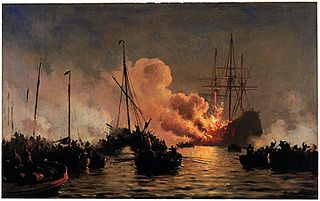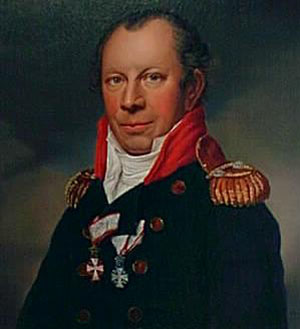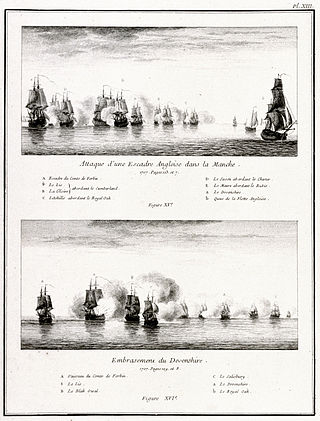
The Third Battle of the Dardanelles in the Fifth Ottoman-Venetian War took place on 26 and 27 June 1656 inside the Dardanelles Strait. The battle was a clear victory for Venice and the Knights Hospitaller over the Ottoman Empire, although their commander, Lorenzo Marcello, was killed on the first day.

The naval Battle of Dynekilen took place on 8 July 1716 during the Great Northern War between a Dano-Norwegian fleet under Peter Tordenskjold and a Swedish fleet under Olof Strömstierna. The battle resulted in a Dano-Norwegian victory.

The Battle of Zealand Point was a naval battle of the English Wars and the Gunboat War. Ships of the Danish and British navies fought off Zealand Point on 22 March 1808; the battle was a British victory. Peter Willemoes was among the Danish casualties,

The action of 22 July 1713 was a naval battle between Sweden and the Tsardom of Russia which took place on 22 July 1713 near the shallows of Kalbådagrund. It was an indecisive engagement, part of the Great Northern War.

The Battle of Fehmarn (1644) took place north-west of the island of Fehmarn, now part of Germany, in the Baltic Sea. A combined Swedish fleet, with a large element of hired Dutch ships, defeated a Danish-Norwegian fleet and took 1,000 prisoners, including Ulfeldt, Grabov and von Jasmund. The Danish admiral Pros Mund was killed in the battle.

The Battle of Køge Bay (1710) also referred to as the Second Battle of Køge Bay, was an indecisive battle that took place on 4 October 1710, during the Great Northern War, in Køge Bay, just south of Copenhagen. Denmark had 26 ships of the line and 5 frigates with 1808 guns, and Sweden had 21 ships of the line and several frigates with 1512 guns. The Danish ship Dannebroge exploded and of the 550-man crew only 9 survived. The Swedish ships Tre Kronor and Prinsessan Ulrika Eleonora ran aground. Because of the weather the battle could not continue. However, the Swedish fleet managed to sink and capture a Danish convoy of transport ships that were supposed to embark a Russian invasion force in Danzig. The action in Køge Bugt checked those Russian invasion plans of Sweden.

This was a series of mainly small-ship actions which occurred along the coast of what is now Ukraine during the Russo-Turkish War (1787–1792) as Russian and Turkish ships and boats supported their land armies in the struggle for control of Ochakov, a strategic position. The main actions at sea happened on 17, 18, 28 and 29 June and 9 July 1788. On 9 July also, the larger Turkish ships left and on 14 July they fought the Russian Sevastopol Squadron about 100 miles to the south.

The Battle of Manila was fought during the Seven Years' War, from 24 September 1762 to 6 October 1762, between the Kingdom of Great Britain and the Kingdom of Spain in and around Manila, the capital of the Philippines, a Spanish colony at that time. The British won, leading to an eighteen-month occupation of Manila.

The Battle of Grengam, Finnish: Flisön taistelu of 1720 was the last major naval battle in the Great Northern War that took place in Åland, in the Ledsund strait between the island communities of Föglö and Lemland. The battle marked the end of Russian and Swedish offensive naval operations in Baltic waters. The Russian fleet conducted one more raid on the Swedish coast in spring 1721, whereupon the Treaty of Nystad was signed, ending the war.

CSS Fanny was a small propeller-driven steam tug used by the Confederate States Navy to defend the sounds of northeastern North Carolina in the American Civil War. Originally armed as a gunboat and operated by the Union, she was captured in October 1861 by the Confederate Navy, and later lost at the Battle of Elizabeth City in February 1862. Due to being used as an observation balloon platform, Fanny is sometimes credited with being the first self-propelled aircraft carrier.

Carl Wilhelm Jessen was a Danish naval officer and Governor of St Thomas in the Danish West Indies.

The action of 2 May 1707, also known as Beachy Head, was a naval battle of the War of the Spanish Succession in which a French squadron under Claude de Forbin intercepted a large British convoy escorted by three ships of the line, under Commodore Baron Wylde. The action began when three French ships, the Grifon, Blackoal and Dauphine, grappled HMS Hampton Court, killing her captain, George Clements, and taking her. Claude Forbin's 60-gun Mars next attacked HMS Grafton and, when joined by the French ships Blackoal and Fidèle, killed the Captain Edward Acton, and took her too. The convoy was scattered and the last British escort, HMS Royal Oak, badly hit and with 12 feet of water in her wells, managed to escape by running ashore near Dungeness, from where she was carried the next day into the Downs.

The Battle of Estepona was a naval battle that occurred in the year 1342 between the armada of the Crown of Aragon, commanded by Admiral Pere de Montcada, against the fleet of the Marinid Dynasty. The battle took place in the Bay of Estepona in the Strait of Gibraltar and resulted in an Aragonese victory and a rout of the Marinid fleet.

The action of 22 May 1812 took place off Groix when a small French squadron comprising the French frigates Ariane and Andromaque, and the brig Mameluck returning from a commerce raiding campaign in the Atlantic, met the 74-gun HMS Northumberland while trying the slip to Lorient through the British blockade.

HDMS Prinds Christian Frederik was a ship of the line in the Royal Dano-Norwegian Navy.















